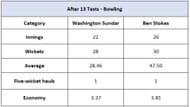The 2025 Anderson-Tendulkar Trophy saw three star all-rounders, Ben Stokes, Ravindra Jadeja, and Washington Sundar, go toe-to-toe with bat and ball. While the England captain stayed true to his all-rounder billing with 304 runs and 17 wickets, the two Indian spin-bowling all-rounders dominated more with the bat than the ball.
Sundar finished the series with 284 runs at an average of over 44, while Jadeja epitomized consistency with 516 runs at an incredible average of 86. However, the duo combined for only 14 wickets in more than 216 overs of bowling.
The build-up to the series saw fans pit Stokes against Jadeja to find out who comes out on top in the all-rounder battle. However, by the end of the series, most shifted their focus to the Sundar-Stokes battle, given the Indian all-rounder's prowess with bat and ball.
Sundar has played only 13 Tests in his career, having debuted in 2021, but boasts excellent all-round numbers. Meanwhile, Stokes is a veteran of 115 Tests and is one of three cricketers with over 7,000 runs and 200 wickets.
Yet, it is hard to remember the England all-rounder's start to his Test career and how he fared at the same stage as Sundar.
In a fun exercise, let us find out which of the two all-rounders between Washington Sundar and Ben Stokes performed better after 13 Tests.
#1 Batting
While Washington Sundar debuted in Tests in hostile territory at Brisbane in 2021, Ben Stokes had it no easier with his debut also coming in Australia in 2013. The two left-handers started their Test career in style with the bat.
Sundar scored a 62 in his maiden innings to help India pull off their famous Brisbane victory in 2021. Meanwhile, Stokes scored his first Test century in only his second game at Perth in 2013.
Here is a table demonstrating the duo's batting numbers after 13 Tests:
 Washington Sundar vs Ben Stokes
Washington Sundar vs Ben StokesDespite predominantly batting lower down the order compared to Stokes, Sundar trumps the England skipper in terms of consistency with the bat. The young Indian all-rounder averages over 44 after 13 Tests, compared to Stokes' 36.
Yet, the English left-hander scored one more century than Sundar at the same stage with almost an additional 100 runs.
Edge: Tie
#2 Bowling
Washington Sundar came into the Indian Test side more as a bowler who can bat in the final Test of the 2020/21 Border-Gavaskar Trophy. Meanwhile, Stokes entered the England setup as a more pure all-rounder, equally divided between bat and ball.
Yet, the duo's bowling numbers after 13 Tests present a stunning case for one over the other.
 Washington Sundar vs Ben Stokes
Washington Sundar vs Ben StokesIt is one-way traffic as far as bowling is concerned between Sundar and Stokes, with the former coming up trumps. Sundar boasts an impressive bowling average of 28.46 after 13 Tests, while Stokes had a dismal average of over 47 at the same stage.
While the duo each have a five-wicket haul at the same period, Sundar's control is considerably better with an economy of 3.37, compared to Stokes' 3.81.
Edge: Washington Sundar
#3 All-round Impact
The ultimate measure of all-rounders is less about numbers and more about their impact on team success. Given that, it would be worthwhile looking at Stokes and Sundar's all-round numbers in team wins after 13 Tests.
 Washington Sundar vs Ben Stokes
Washington Sundar vs Ben StokesStokes was on the winning side in only three out of his first 13 Tests, while Sundar doubled him up by winning six out of his first 13 red-ball outings. In the victories, the Indian youngster has averaged an impressive 43.25 with the willow and 41 with the ball.
However, Stokes trumps Sundar with the bat in Test wins, averaging an incredible 59. Yet, his bowling average plummets to a sub-par 63.40 in England Test wins in his first 13 Tests.
Edge: Tie
Verdict: Washington Sundar has Ben Stokes beat in more key categories after their respective first 13 Tests.
Why did you not like this content?
- Clickbait / Misleading
- Factually Incorrect
- Hateful or Abusive
- Baseless Opinion
- Too Many Ads
- Other
Was this article helpful?
Thank You for feedback
About the author
Follow IPL Auction 2025 Live Updates, News & Biddings at Sportskeeda. Get the fastest updates on Mega-Auction and cricket news
Edited by Venkatesh Ravichandran

.jpg) 16 hours ago
2
16 hours ago
2

 English (US)
English (US)